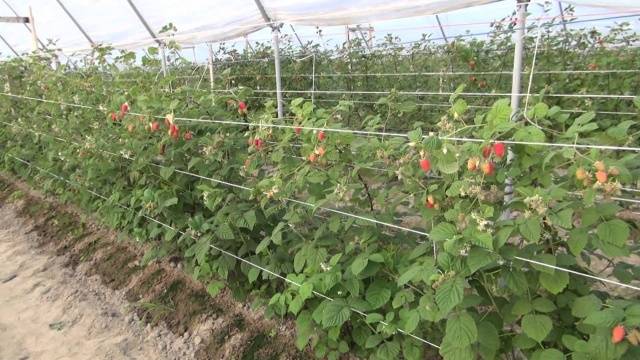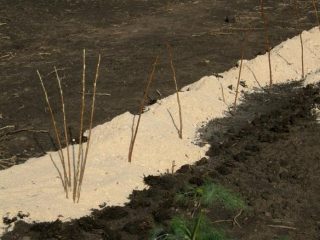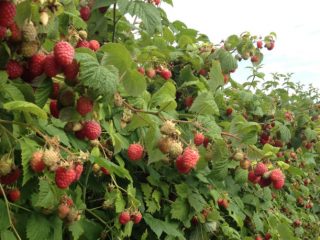Content
The berry season is very short, two or three weeks - and you have to wait another whole year for a new harvest. To extend the season, breeders have developed remontant raspberry varieties that bear fruit several times, the first time on last year's shoots, the second time on shoots that grew this season. One of these varieties is the Hercules raspberry.
Description
The raspberry variety “Hercules” was bred by domestic breeders. Recommended for cultivation in the Central region, but is also successfully grown in more southern and northern regions. Used for cultivation in private farms and for industrial production.
The main advantages of this variety:
- High yield;
- Great taste;
- Frost resistance;
- Resistance to adverse weather conditions;
- Resistance to berry falling;
- Fruiting on new shoots.
Raspberry berries of the “Hercules” variety are very large, weighing up to 12 grams, have dense skin and small seeds. Due to the density of the skin, they can easily withstand long-term transportation without losing their presentation.
Raspberry bushes of the “Hercules” variety are medium, up to 2 meters high. The branches are dense, strong, and do not bend under the weight of berries. Green branches are quite resistant to gusts of wind; woody shoots from last year can break off. Does not require a garter. The branches are densely covered with small thorns. Up to 6 shoots are formed annually. The fruiting zone occupies one third of the shoot.
Fruiting is friendly and abundant. The first wave of fruiting occurs at the end of June; berries are formed on last year's shoots. The second wave of fruiting occurs at the end of August or beginning of September, and may continue until the first frost. The total number of berries reaches 1.5 kg. With a high level of agricultural technology, Hercules raspberries can produce up to 2 kg of berries per bush.
Landing
To plant Hercules raspberry bushes, it is advisable to choose a well-lit place, sheltered from the northern winds. This raspberry can bear fruit quite successfully in shady areas illuminated by direct sunlight only in the first half of the day.
Raspberry bushes are planted in the spring, before green buds form, or in the fall, when the raspberry bushes are already dormant.
To grow Hercules raspberries, it is important to take into account the characteristics of the soil. Raspberry bushes can develop successfully in all soils except those that are depleted and have high acidity. Before planting raspberry bushes, depleted soils must be fertilized, and lime must be added to acidic soils to reduce acidity.
Before planting raspberry bushes, the soil is freed from perennial weed, dig up and fertilize. Since raspberries grow in one place for quite a long time without transplanting, long-acting fertilizers can be applied. The dosage is determined according to the instructions.
To control beds with raspberry bushes, you can dig a fence around the perimeter of the bed to a depth of 40–50 cm.The fencing material should be thick enough to hold the raspberry roots. You can use sheets of old slate.
The distance between planting holes must be at least 65 cm. You can plant raspberry bushes using the one-line or two-line method. It is necessary to leave a distance between the rows so that you can easily care for the bushes. As a rule, 80–90 cm is sufficient.
The root system of raspberries is shallow, so the depth of the planting hole can be no more than 50 cm. Organic fertilizers, a glass of wood ash and 2 - 3 liters of humus are added to the bottom of the planting hole.
The planted raspberry bushes are covered with soil and generously filled with water. After 2–3 days, it is advisable to repeat watering.
It is very convenient to use old cardboard boxes for these purposes. Cover the soil around the planted raspberry bushes with cardboard, sprinkling a layer of earth on top.
Care
The description of the Hercules raspberry variety states that it is undemanding, but to get large berries, like in the photo, you need to put in a little effort. Caring for raspberries of the “Hercules” variety consists of watering, fertilizing, removing weeds, protecting bushes from pests, and timely harvesting.
Watering is carried out as needed, generously flooding the bushes. If the soil around the bushes is covered with mulching material, the number of waterings can be reduced.
It can prevent young shoots from emerging from the ground.
Fertilizer application is necessary on soils poor in nutrients; the development of raspberries is difficult.The berries become smaller, the bushes develop poorly, and more often suffer from diseases and freezing in winter.
The first application of fertilizers is carried out in the spring, before the first leaves appear on the bushes. During this period, Hercules raspberries most of all need nitrogen and phosphorus for the formation of green mass and shoots. Nutrients are added to the tree trunk in accordance with the instructions, dug in a little and water the bushes abundantly.
Overfed raspberry bushes bear scant fruit, and fruiting begins much later.
The maintainability of the Hercules raspberry variety can be used to get a larger harvest at a time. To do this, in the fall, fruit-bearing shoots are cut off at the root. Next year's harvest will be formed on new shoots, the berries will be larger, and their total weight will be higher. In this case, raspberry fruiting will begin at the beginning or end of August, depending on the region.
This method is also recommended for northern regions, where Hercules raspberry bushes can freeze and break off in winter. In addition, the berries of the second wave of fruiting may not have time to ripen before frost.
Planting and caring for raspberry bushes of the “Hercules” variety is not particularly difficult; in order to reap a rich harvest of aromatic berries, you just need to give it a little attention and love.
Reviews













